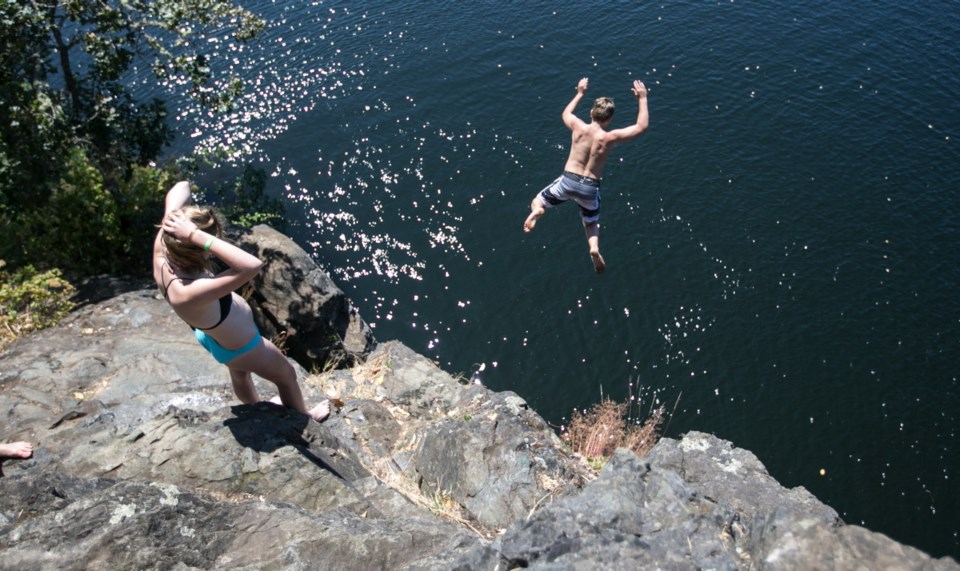A young woman who suffered serious injuries when she slipped off a cliff, hit her head on rocks and ended up unconscious in Thetis Lake would have drowned had others in the water not kept her afloat until rescuers — 18 of them — arrived.
Langford father Tim Benetti said Monday that he witnessed the immediate aftermath of the July 7 accident and told his nine-year-old son and his friends on the main beach to take the incident as a warning. “It’s crazy,” he said of the common practice of cliff jumping. “This is what can happen.”
Death by falling or jumping into water is anything but rare, according to just-released statistics from the B.C. Coroners Service.
Coroners’ statistics show 128 people accidentally drowned from 2008 through 2016 after jumping or falling into water or through ice across the province — 110 of them by falling into water and 18 after jumping from heights. Those deaths account for nearly 20 per cent of all 666 accidental drownings in that period.
The B.C. Injury Research and Prevention Unit notes a further 175 near-drownings per year, an estimated 1,600 in the nine-year period, of which an estimated 20 per cent of survivors suffer permanent brain damage.
View Royal Fire Chief Paul Hurst said people have died from jumps or falls from the Thetis cliffs and he’s not sure what the answer is in preventing more such traumatic events. If a fence were installed on the east side of the lake, it’s likely people would just jump over it, he said.
“I don’t know how you monitor this or control it. [But] we can’t ignore the fact that people are being seriously injured and killed. There needs to be some sort of action.”
He suggested the Capital Regional District, which administers the lake, needs to have “a serious conversation” about solutions. “People say it’s not going to happen to them, but when it does, it’s going to be messy,” Hurst said.
View Royal Mayor David Screech has renewed his call to the CRD to fund a lifeguard at Thetis Lake’s main beach. The position was discontinued in 2003 over issues including funding and finding well-qualified staff. “I think that’s negligence — they’re not adequately staffing public space,” said Logan MacLeod, 25, who was visiting the lake from the Fraser Valley on Monday.
Vic West mother Vaughn Chanakos, a former paramedic, said it’s “just ridiculous” not to have a lifeguard on duty, not just at Thetis but throughout the region. “There should be one at every single public beach, especially if there’s a campsite.”
There wouldn’t be a shortage of well-qualified lifequards if young people knew they could get jobs on regional beaches, she said.
Benetti, who swam the circumference of Thetis Lake twice on Monday, said that just last week, a panicky woman from the Caribbean approached him because her friend, a non-swimmer not wearing a life jacket, was being blown to the middle of the lake on his air mattress. Fortunately, a CRD maintenance employee nearby was able to alert two canoeists to tow the man back.
Benetti said in the absence of a lifeguard, he was prepared to swim out and rescue the man. Last year, he said, he lugged a Japanese teenage girl to safety when she walked into the lake fully dressed and disappeared suddenly when the water became deep. A lifeguard is needed, he said, adding at the very least, there should be warning signs in foreign languages and a rope with floaters marking the deep zone.
According to the LIfeSaving Society, B.C. and Yukon Branch, newcomers to Canada — especially those here less than five years — are more likely to drown than native Canadians. “In fact, they are four times more likely to be unable to swim than those born in Canada.”
On June 27, two students from Japan had a brush with death when they found themselves sinking in Thetis Lake near Sunnyside cliffs beach. The two were rescued by two girls on paddleboards and a man in a fishing float tube.
International students drowned at Thetis Lake in 1999, 2006 and 2013.
“People don’t realize how quickly they can get into trouble — particularly when they’re in unfamiliar waters,” chief coroner Lisa Lapointe said in a statement. Not only are B.C. waters frequently much colder than waters elsewhere, they’re known for sudden drop-offs, underwater obstacles and unstable or slippery rock edges.
Preliminary figures for 2016 shows 47 accidental drownings, the lowest in the past decade, down from 80 in 2015.
• Lakes and ponds account for 31 per cent of drownings, rivers and creeks for 30 per cent and the ocean for 20 per cent.
• Consuming drugs, alcohol or both was a factor in 40 per cent of B.C. drownings from 2008 to 2015.
• Vancouver Island drownings dropped to 14 last year, compared to a high of 19 in 2014.
• Drownings of females are increasing, and now account for 25 per cent of such deaths. Overall, those most likely to drown are age 19 to 29 or in their 50s. Children nine and under accounted for 2.7 per cent of drowning deaths.
B.C. will host this year’s World Conference on Drowning Prevention from Oct. 17-19 in Vancouver.



